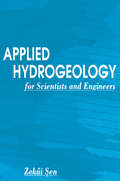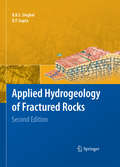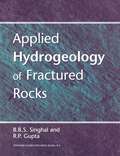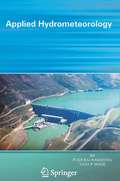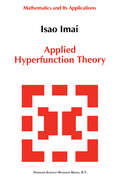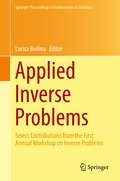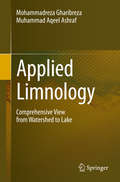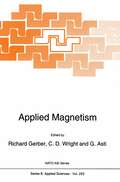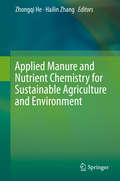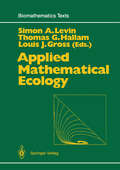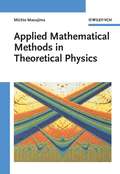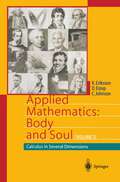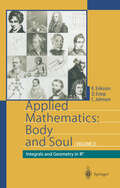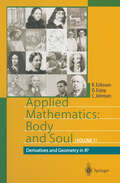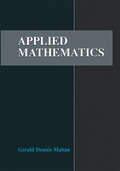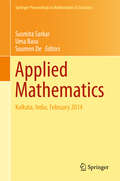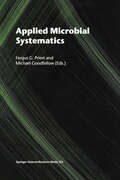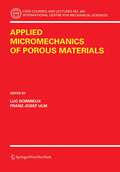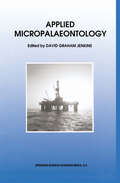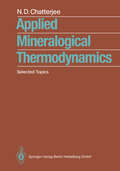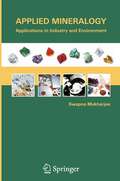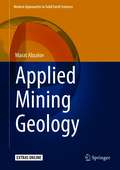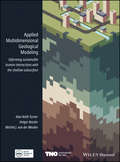- Table View
- List View
Applied Hydrogeology for Scientists and Engineers
by Zekai SenIn order to properly plan, design, and operate groundwater resources projects, it is necessary to measure - over time or distance - pertinent groundwater variables such as drawdown and discharge in the field. Applied Hydrogeology for Scientists and Engineers shows how to assess and interpret these data by subsurface geological setup and processing. The book helps readers estimate relevant groundwater parameters such as storativity, transmissivity, and leakage coefficient.The text addresses many interrelated disciplines such as geology, hydrology, hydrogeology, engineering, petroleum geology, and water engineering. Traditional and current models for application are presented. One of the unique features of the book is the inclusion of new and previously unpublished ideas, concepts, techniques, approaches, and procedures developed by the author. Among these are hydrogeophysical concepts, slope matching techniques, volumetric approach solution for complicated groundwater flows, non-Darcian flow law applications, aquifer sample functions, dimensionless-type straight line methods, non-linear flow-type curves, discharge calculations from early time-drawdown data, storage coefficient estimation procedure for quasi-steady state flow, and much more. The pitfalls in aquifer test analysis are also detailed. Fractured medium flow adds yet another dimension to the book. Each method is supplemented by actual field data applications from worldwide case studies.Applied Hydrogeology for Scientists and Engineers covers the topics of groundwater reservoirs, the evaluation of aquifer parameters, aquifer and flow properties, flow properties and bore hole tests, aquifer tests in porous and fractured media, well hydraulics, groundwater flow and aquifer tests, and field measurements and their interpretations.This new reference also works well as a post-graduate textbook on the subject. Applied Hydrogeology for Scientists and Engineers expands the reader's knowledge by providing valuable information not found in any other publication.
Applied Hydrogeology of Fractured Rocks: Second Edition
by B.B.S. Singhal † R.P. GuptaHydrogeology is a topical and growing subject as the earth's water resources become scarcer and more vulnerable. More than half of the surface area of continents is covered with hard rocks of low permiability. This book deals comprehensively with the fundamental principles for understanding the hydrogeological characteristics of rocks, as well as exploration techniques and assessment. It also provides in depth discussion on structural mapping, remote sensing, geophysical exploration, GIS, groundwater flow modelling and contaminant transport, field hydraulic testing including tracer tests, groundwater quality, geothermal reservoirs, managed aquifer recharge, and resources assessment and management. Hydrogeological aspects of various lithology groups, including crystalline rocks, volcanic rocks, carbonate rocks and clastic formations have been dealt with separately, using and discussing examples from all over the world. It will be an invaluable text book cum reference source for postgraduate students, researchers, exploration scientists and engineers engaged in the field of groundwater development in fractured rocks. Applied Hydrogeology of Fractured Rocks - Second Edition is thoroughly revised and extended with a new chapter, updated sections, many new examples, and expanded and updated references.
Applied Hydrogeology of Fractured Rocks
by B.B.S. Singhal † R.P. GuptaHydrology is a topical and growing subject, as the earth's water resources become scarcer and more vulnerable. Although more than half the surface area of continents is covered with hard fractured rocks, there has until now been no single book available dealing specifically with fractured rock hydrogeology. This book deals comprehensively with the fundamental principles for understanding these rocks, as well as with exploration techniques and assessment. It also provides in-depth discussion of structural mapping, remote sensing, geophysical exploration, GIS, field hydraulic testing, groundwater quality and contamination, geothermal reservoirs, and resources assessment and management. Hydrogeological aspects of various lithology groups, including crystalline rocks, volcanic rocks, carbonate rocks and clastic formations, are dealt with separately, using and discussing examples from all over the world. Applied Hydrogeology of Fractured Rocks will be an invaluable reference source for postgraduate students, researchers, exploration scientists, and engineers engaged in the field of groundwater development in fractured rock areas.
Applied Hydrogeophysics (Nato Science Series: IV: #71)
by Harry Vereecken Andrew Binley Giorgio Cassiani André Revil Konstantin TitovThis book focuses on the the application of hydrogeophysical methods to the understanding of hydrological processes and environmental problems dealing with the flow of water and the transport of solutes and contaminants. Taking a process-driven approach, the book offers a series of process-driven chapters, each authored by leading experts. Areas covered include: infiltration and solute transport processes, biogeochemical functioning of soil-water systems, coastal groundwater interactions, cold region hydrology, engineered barriers and landfill processes.
Applied Hydrometeorology
by Pukhraj Rakhecha Vijay P. SinghWater is vital for life. Since the dawn of civilization, much effort has been made to harness sources of fresh water. Recent years have raised global awareness of the need for increasing demand of water worldwide, largely because of growing population, rising standard of living, higher demand for energy, and greater appreciation for environmental quality. As an example, the world population has increased threefold in the past five decades. In order to meet the rising water demand, water resources are being developed by building large dams, reservoirs, barrages and weirs across rivers worldwide. The guiding principle for water resources development has been to ensure adequate supply of water for agriculture, domestic use (including fine drinking water), waste disposal, industries, and energy production, with due attention to maintain the ecosystem functions. This development, however, depends on a holistic, cooperative and scientific approach. The basic inputs in the assessment of water resources for a given region are from hydrological data and the subject of hydrology forms the core in achieving sustainable development of water resources. Barring a few exceptions, hydrological data for most river basins are sparse and therefore it is difficult to comprehensively assess their water resources. The major source of water is rainfall which occurs as a result of condensation of atmospheric moisture governed by the science of meteorology.
Applied Hyperfunction Theory (Mathematics and its Applications #8)
by Isao ImaiGeneralized functions are now widely recognized as important mathematical tools for engineers and physicists. But they are considered to be inaccessible for non-specialists. To remedy this situation, this book gives an intelligible exposition of generalized functions based on Sato's hyperfunction, which is essentially the `boundary value of analytic functions'. An intuitive image -- hyperfunction = vortex layer -- is adopted, and only an elementary knowledge of complex function theory is assumed. The treatment is entirely self-contained. The first part of the book gives a detailed account of fundamental operations such as the four arithmetical operations applicable to hyperfunctions, namely differentiation, integration, and convolution, as well as Fourier transform. Fourier series are seen to be nothing but periodic hyperfunctions. In the second part, based on the general theory, the Hilbert transform and Poisson-Schwarz integral formula are treated and their application to integral equations is studied. A great number of formulas obtained in the course of treatment are summarized as tables in the appendix. In particular, those concerning convolution, the Hilbert transform and Fourier transform contain much new material. For mathematicians, mathematical physicists and engineers whose work involves generalized functions.
Applied Inverse Problems: Select Contributions from the First Annual Workshop on Inverse Problems (Springer Proceedings in Mathematics & Statistics #48)
by Larisa BeilinaThis proceedings volume is based on papers presented at the First Annual Workshop on Inverse Problems which was held in June 2011 at the Department of Mathematics, Chalmers University of Technology. The purpose of the workshop was to present new analytical developments and numerical methods for solutions of inverse problems. State-of-the-art and future challenges in solving inverse problems for a broad range of applications was also discussed. The contributions in this volume are reflective of these themes and will be beneficial to researchers in this area.
Applied Limnology: Comprehensive View from Watershed to Lake
by Mohammadreza Gharibreza Muhammad Aqeel AshrafA multidisciplinary study of Bera Lake in Malaysia is presented here, focusing on natural resources throughout the lake’s catchment area and assessing environmental impact. This applied limnology study examines issues relating to land development including soil erosion and nutrient loss in the catchment area, severe pollution of water, sediment resources in open waters and wetlands, and reduction of aquatic and bird populations. The chapters provide a comprehensive view of problems, risks and possible mitigation measures associated with this great natural habitat. The book highlights the technology and methods used to estimate both soil erosion rate and nutrient loss from the lake catchment, including an explanation of the measurement of the sedimentation rate in Bera Lake using 137Cs and 210Pb radioisotopes. The author examines the current and historic situation of contamination in sediments, presents an ecological risk assessment, and finally describes a master management plan, proposing practices to mitigate the environmental impacts of existing agricultural projects and practices to control future projects. Readers will learn of a decrease in the watershed supply of water to Bera Lake, of shoaling, degradation of water and sediment quality, and the extinction of several kinds of flora and fauna. This volume also offers an approach to sustainable land use with regard to natural resources conservation.
Applied Magnetism (NATO Science Series E: #253)
by R. Gerber C. D. Wright G. AstiThis book is based on the contributions to a course, entitled Applied Magnetism, which was the 25th Course of the International School of Materials Science and Technology. The Course was held as a NATO Advanced Study Institute at the Ettore Majorana Centre in Erice, Sicily, Italy between the 1st and 12th July 1992, and attracted almost 70 participants from 15 different countries. The book deals with the theory, experiments and applications of the main topical areas of applied magnetism. These selected areas include the physics of magnetic recording, magnetic and magneto-optic recording devices, systems and media, magnetic fine particles, magnetic separation, domains and domain walls in soft magnetic materials, permanent magnets, magnetoresistance, thin film magneto-optics, and finally, microwave, optical and computational magnetics. The material is organised into I 0 self-contained chapters which together provide a comprehensive coverage of the subject of applied magnetism. The aim is to emphasise the connection between the fundamental theoretical concepts, key experiments and the important technological developments which have been achieved in this field up to the present time. Moreover, when and where possible, pointers to future trends are indicated which hopefully, together with the background material, will promote further advancement of research. The organizing committee would like to acknowledge the sponsorship of the NATO Scientific Affairs Division, the National Science Foundation of the USA, the Science and Engineering Research Council of the UK, the Italian Ministry of Education, the Italian Ministry of University and Scientific Research and the Sicilian Regional Government.
Applied Manure and Nutrient Chemistry for Sustainable Agriculture and Environment
by Zhongqi He Hailin ZhangDue to the rapid increase in world population and improving living standards, the global agriculture sector is confronting with challenges for the sustainability of agricultural production and of the environment. Intensive high-yield agriculture is typically dependent on addition of fertilizers (synthetic chemicals, animal manure, etc.). However, non-point nutrient losses from agricultural fields due to fertilization could adversely impact the environment. Increased knowledge on plant nutrient chemistry is required for improving utilization efficiency and minimizing loses from both inorganic and organic nutrient sources. For this purpose, the book is composed of 19 chapters that highlight recent research activities in applied nutrient chemistry geared toward sustainable agriculture and environment. Topics of interest include, but are not limited, to speciation, quantification, and interactions of various plant nutrients and relevant contributories in manure, soil, and plants. This book outlooks emerging researchable issues on alternative utilization and environmental monitoring of manure and other agricultural by products that may stimulate new research ideas and direction in the relevant fields.
Applied Mathematical Ecology (Biomathematics #18)
The Second Autumn Course on Mathematical Ecology was held at the Intern ational Centre for Theoretical Physics in Trieste, Italy in November and December of 1986. During the four year period that had elapsed since the First Autumn Course on Mathematical Ecology, sufficient progress had been made in applied mathemat ical ecology to merit tilting the balance maintained between theoretical aspects and applications in the 1982 Course toward applications. The course format, while similar to that of the first Autumn Course on Mathematical Ecology, consequently focused upon applications of mathematical ecology. Current areas of application are almost as diverse as the spectrum covered by ecology. The topiys of this book reflect this diversity and were chosen because of perceived interest and utility to developing countries. Topical lectures began with foundational material mostly derived from Math ematical Ecology: An Introduction (a compilation of the lectures of the 1982 course published by Springer-Verlag in this series, Volume 17) and, when possible, progressed to the frontiers of research. In addition to the course lectures, workshops were arranged for small groups to supplement and enhance the learning experience. Other perspectives were provided through presentations by course participants and speakers at the associated Research Conference. Many of the research papers are in a companion volume, Mathematical Ecology: Proceedings Trieste 1986, published by World Scientific Press in 1988. This book is structured primarily by application area. Part II provides an introduction to mathematical and statistical applications in resource management.
Applied Mathematical Methods in Theoretical Physics
by Michio MasujimaAll there is to know about functional analysis, integral equations and calculus of variations in a single volume. This advanced textbook is divided into two parts: The first on integral equations and the second on the calculus of variations. It begins with a short introduction to functional analysis, including a short review of complex analysis, before continuing a systematic discussion of different types of equations, such as Volterra integral equations, singular integral equations of Cauchy type, integral equations of the Fredholm type, with a special emphasis on Wiener-Hopf integral equations and Wiener-Hopf sum equations. After a few remarks on the historical development, the second part starts with an introduction to the calculus of variations and the relationship between integral equations and applications of the calculus of variations. It further covers applications of the calculus of variations developed in the second half of the 20th century in the fields of quantum mechanics, quantum statistical mechanics and quantum field theory. Throughout the book, the author presents over 150 problems and exercises - many from such branches of physics as quantum mechanics, quantum statistical mechanics, and quantum field theory - together with outlines of the solutions in each case. Detailed solutions are given, supplementing the materials discussed in the main text, allowing problems to be solved making direct use of the method illustrated. The original references are given for difficult problems. The result is complete coverage of the mathematical tools and techniques used by physicists and applied mathematicians Intended for senior undergraduates and first-year graduates in science and engineering, this is equally useful as a reference and self-study guide.
Applied Mathematics: Calculus in Several Dimensions
by Kenneth Eriksson Donald Estep Claes JohnsonApplied Mathematics: Body & Soul is a mathematics education reform project developed at Chalmers University of Technology and includes a series of volumes and software. The program is motivated by the computer revolution opening new possibilitites of computational mathematical modeling in mathematics, science and engineering. It consists of a synthesis of Mathematical Analysis (Soul), Numerical Computation (Body) and Application. Volumes I-III present a modern version of Calculus and Linear Algebra, including constructive/numerical techniques and applications intended for undergraduate programs in engineering and science. Further volumes present topics such as Dynamical Systems, Fluid Dynamics, Solid Mechanics and Electro-Magnetics on an advanced undergraduate/graduate level. The authors are leading researchers in Computational Mathematics who have written various successful books.
Applied Mathematics: Volume 2: Integrals and Geometry in IRn
by Kenneth Eriksson Donald Estep Claes JohnsonApplied Mathematics: Body & Soul is a mathematics education reform project developed at Chalmers University of Technology and includes a series of volumes and software. The program is motivated by the computer revolution opening new possibilities of computational mathematical modeling in mathematics, science and engineering. It consists of a synthesis of Mathematical Analysis (Soul), Numerical Computation (Body) and Application. Volumes I-III present a modern version of Calculus and Linear Algebra, including constructive/numerical techniques and applications intended for undergraduate programs in engineering and science. Further volumes present topics such as Dynamical Systems, Fluid Dynamics, Solid Mechanics and Electro-Magnetics on an advanced undergraduate/graduate level. The authors are leading researchers in Computational Mathematics who have written various successful books.
Applied Mathematics: Volume 1: Derivatives and Geometry in IR3
by Kenneth Eriksson Donald Estep Claes JohnsonApplied Mathematics: Body & Soul is a mathematics education reform project developed at Chalmers University of Technology and includes a series of volumes and software. The program is motivated by the computer revolution opening new possibilitites of computational mathematical modeling in mathematics, science and engineering. It consists of a synthesis of Mathematical Analysis (Soul), Numerical Computation (Body) and Application. Volumes I-III present a modern version of Calculus and Linear Algebra, including constructive/numerical techniques and applications intended for undergraduate programs in engineering and science. Further volumes present topics such as Dynamical Systems, Fluid Dynamics, Solid Mechanics and Electro-Magnetics on an advanced undergraduate/graduate level. The authors are leading researchers in Computational Mathematics who have written various successful books.
Applied Mathematics
by Gerald D. MahanThis volume is a textbook for a year-long graduate level course in All research universities have applied mathematics for scientists and engineers. such a course, which could be taught in different departments, such as mathematics, physics, or engineering. I volunteered to teach this course when I realized that my own research students did not learn much in this course at my university. Then I learned that the available textbooks were too introduc tory. While teaching this course without an assigned text, I wrote up my lecture notes and gave them to the students. This textbook is a result of that endeavor. When I took this course many, many, years ago, the primary references were the two volumes of P. M. Morse and H. Feshbach, Methods of Theoretical Physics (McGraw-Hill, 1953). The present text returns the contents to a similar level, although the syllabus is quite different than given in this venerable pair of books.
Applied Mathematics: Kolkata, India, February 2014 (Springer Proceedings in Mathematics & Statistics #146)
by Susmita Sarkar Uma Basu Soumen DeThe book is based on research presentations at the international conference, “Emerging Trends in Applied Mathematics: In the Memory of Sir Asutosh Mookerjee, S.N. Bose, M.N. Saha and N.R. Sen”, held at the Department of Applied Mathematics, University of Calcutta, during 12–14 February 2014. It focuses on various emerging and challenging topics in the field of applied mathematics and theoretical physics. The book will be a valuable resource for postgraduate students at higher levels and researchers in applied mathematics and theoretical physics.Researchers presented a wide variety of themes in applied mathematics and theoretical physics—such as emergent periodicity in a field of chaos; Ricci flow equation and Poincare conjecture; Bose–Einstein condensation; geometry of local scale invariance and turbulence; statistical mechanics of human resource allocation: mathematical modelling of job-matching in labour markets; contact problem in elasticity; the Saha equation; computational fluid dynamics with applications in aerospace problems; an introduction to data assimilation, stochastic analysis and bounds on noise for Holling type-II model, graph theoretical invariants of chemical and biological systems; strongly correlated phases and quantum phase transitions of ultra cold bosons; and the mathematical modelling of breast cancer treatment.
Applied Microbial Systematics
by F. G. Priest Michael GoodfellowModern approaches to microbial classification and identification, particularly those based on nucleic acid analysis, have raised the awareness and interest of microbiologists in systematics during the past decade. The extended scope of the subject has revolutionized microbial ecology with the demonstration of uncultivable microorganisms as a major component of the biosphere and evolution, with the ribosomal RNA phylogenetic tree as the basis of current classifications. However, advances in microbial systematics have also had enormous impact on other, diverse aspects of microbiology such as animal pathogenicity, plant-microbe interactions and relationships with food. In this book, we survey and discuss in depth the contribution of modern taxonomic approaches to our understanding of the microbiology of these various systems. The book does not concentrate on methods - these have been well reported elsewhere - instead it provides a unique insight into the application and value of modern systematics in diverse branches of microbiology. It will be of value to microbiologists at both research and technical levels who need to appreciate the range of organisms with which they work and the diversity within them. It will also be of value to teachers and students of microbiology courses who want to understand how systematics can enhance microbiology beyond the routine of classification, nomenclature, and identification.
Applied Micromechanics of Porous Materials (CISM International Centre for Mechanical Sciences #480)
by Luc Dormieux Franz-Josef UlmPoromechanics is the mechanics of porous materials and is now a well established field in many engineering disciplines, ranging from Civil Engineering, Geophysics, Petroleum Engineering to Bioengineering. However, a rigorous approach that links the physics of the phenomena at stake in porous materials and the macroscopic behaviour is still missing. This book presents such an approach by means of homogenization techniques. Rigorously founded in various theories of micromechanics, these up scaling techniques are developed for the homogenization of transport properties, stiffness and strength properties of porous materials. The special feature of this book is the balance between theory and application, providing the reader with a comprehensive introduction to state-of-the-art homogenization theories and applications to a large range of real life porous materials: concrete, rocks, shales, bones, etc.
Applied Micropalaeontology
by J. M. JenkinsSeven original case-studies are presented in this volume, each describing the application of micropaleontology and palynology in applied geology: (1) a study of the modern distribution of coccolith sedimentation in the North Sea and its potential for future application in basin analysis; (2) ostracods are shown to be good paleoenvironmental indicators in the early Cretaceous and Tertiary; (3) a biogenic gas seep in the North Sea is shown to be marked by diagnostic benthonic foraminifera; (4) in the North Sea hydrocarbon exploration, integrated studies of micropaleontology have provided invaluable data; (5) palynofacies analysis are shown to be vital in determining depositional events and hydrocarbon source rock potential; (6) the application of paleontology and sedimentology to sequence stratigraphy is demonstrated in the early Cretaceous; and (7) the application of micropaleontology is shown to be an essential tool in both engineering and economic geology. Most chapters have been prepared by earth scientists from industry. The study of microfossils presented in this book provides invaluable data for stratigraphers, petroleum geologists and for engineers and economic geologists working in hydrocarbon exploration and basin analysis.
Applied Mineralogical Thermodynamics: Selected Topics
by Niranjan D. ChatterjeeThermodynamic treatment of mineral equilibria, a topic central to mineralogical thermodynamics, can be traced back to the tum of the century, when J. H. Van't Hoff and his associates pioneered in applying thermodynamics to the mineral assemblages observed in the Stassfurt salt deposit. Although other renowned researchers joined forces to develop the subject - H. E. Boeke even tried to popularize it by giving an overview of the early developments in his "Grundlagen der physikalisch-chemischen Petrographie", Berlin, 1915 - it remained, on the whole, an esoteric subject for the majority of the contemporary geological community. Seen that way, mineralogical thermodynamics came of age during the last four decades, and evolved very rapidly into a mainstream discipline of geochemistry. It has contributed enormously to our understanding of the phase equilibria of mineral systems, and has helped put mineralogy and petrology on a firm quantitative basis. In the wake of these developments, academic curricula now require the students of geology to take a course in basic thermodynamics, traditionally offered by the departments of chemistry. Building on that foundation, a supplementary course is generally offered to familiarize the students with diverse mineralogical applications of thermo dynamics. This book draws from the author's experience in giving such a course, and has been tailored to cater to those who have had a previous exposure to the basic concepts of chemical thermodynamics.
Applied Mineralogy: Applications in Industry and Environment
by Swapna MukherjeeThis book covers the entire spectrum of mineralogy and consolidates its applications in different fields. Part I starts with the very basic concept of mineralogy describing in detail the implications of the various aspects of mineral chemistry, crystallographic structures and their effects producing different mineral properties. Part II of the book describes different aspects of mineralogy like geothermobarometry, mineral thermodynamics and phase diagrams, mineral exploration and analysis, and marine minerals. Finally Part III handles the applications in industrial, medicinal and environmental mineralogy along with precious and semiprecious stone studies. The various analytical techniques and their significance in handling specific types of mineralogical problems are also covered.
Applied Mining Geology (Modern Approaches in Solid Earth Sciences #12)
by Marat AbzalovThis book provides a detailed overview of the operational principles of modern mining geology, which are presented as a good mix of theory and practice, allowing use by a broad range of specialists, from students to lecturers and experienced geologists.The book includes comprehensive descriptions of mining geology techniques, including conventional methods and new approaches. The attributes presented in the book can be used as a reference and as a guide by mining industry specialists developing mining projects and for optimizing mining geology procedures. Applications of the methods are explained using case studies and are facilitated by the computer scripts added to the book as Electronic Supplementary Material.
Applied Multidimensional Geological Modeling: Informing Sustainable Human Interactions with the Shallow Subsurface
by A. Keith TurnerOver the past decades, geological survey organizations have digitized their data handling and holdings, unlocking vast amounts of data and information for computer processing. They have undertaken 3-D modeling alongside, and in some cases instead of, conventional geological mapping and begun delivering both data and interpretations to increasingly diverse stakeholder communities. Applied Multidimensional Geological Modeling provides a citable central source that documents the current capabilities and contributions of leading geological survey organization and other practitioners in industry and academia that are producing multidimensional geological models. This book focuses on applications related to human interactions with conditions in the shallow subsurface, within 100-200 m of the surface. The 26 chapters, developed by 100 contributors associated with 37 organizations, discuss topics relevant to any geologist, scientist, engineer, urban planner, or decision maker whose practice includes assessment or planning of underground space.
Applied Multidimensional Geological Modeling: Informing Sustainable Human Interactions with the Shallow Subsurface
by A. Keith Turner Michiel Van Der Meulen Holger KesslerOver the past decades, geological survey organizations have digitized their data handling and holdings, unlocking vast amounts of data and information for computer processing. They have undertaken 3-D modeling alongside, and in some cases instead of, conventional geological mapping and begun delivering both data and interpretations to increasingly diverse stakeholder communities. Applied Multidimensional Geological Modeling provides a citable central source that documents the current capabilities and contributions of leading geological survey organization and other practitioners in industry and academia that are producing multidimensional geological models. This book focuses on applications related to human interactions with conditions in the shallow subsurface, within 100-200 m of the surface. The 26 chapters, developed by 100 contributors associated with 37 organizations, discuss topics relevant to any geologist, scientist, engineer, urban planner, or decision maker whose practice includes assessment or planning of underground space.
